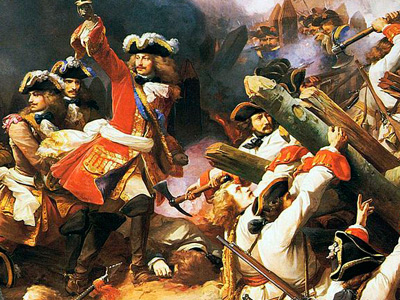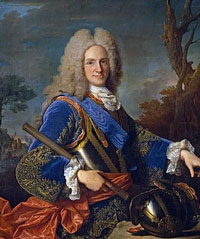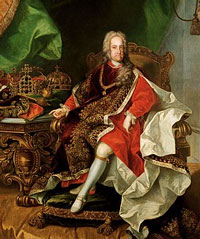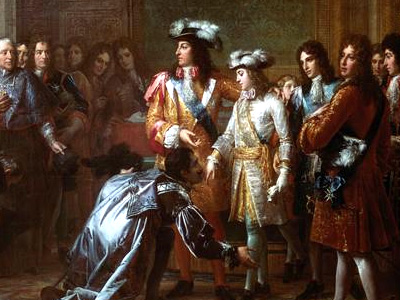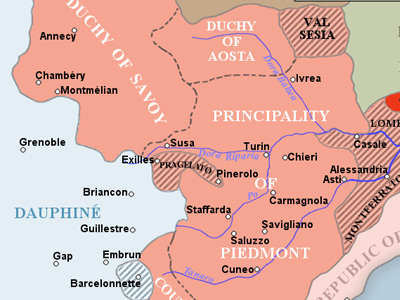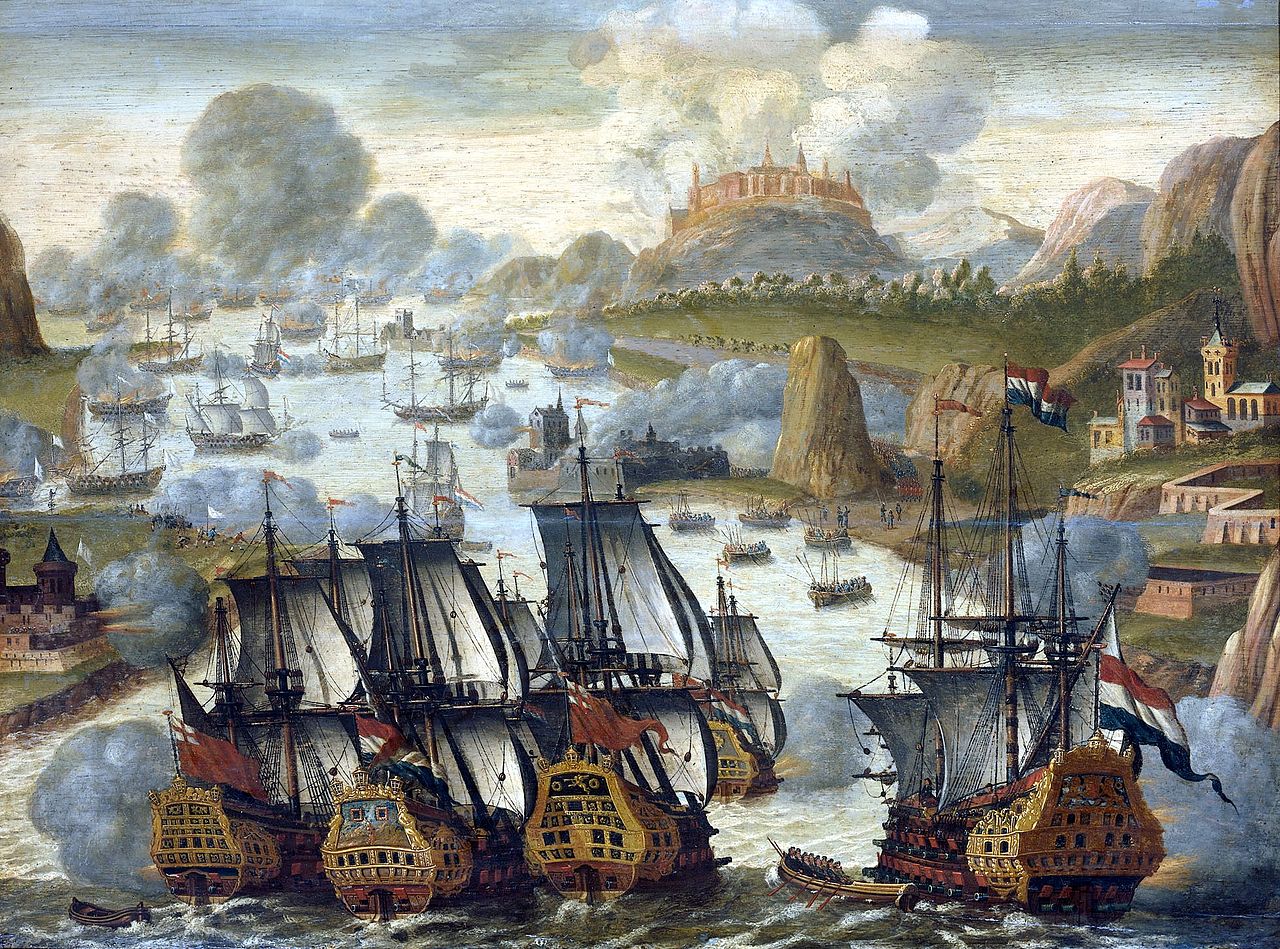War of the Spanish Succession (1702–1715)
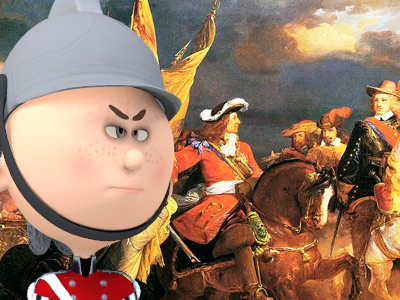
The War of the Spanish Succession (1702–1715) was a major European conflict of the early 18th century, triggered by the death in 1700 of the last Habsburg King of Spain, the infirm and childless Charles II. Charles II had ruled over a large active Spanish Empire The Spanish Empire was a colonial empire governed by Spain and its predecessor states between 1492 and 1976. One of the largest empires in history, it was the first to usher the European Age of Discovery and achieve a global scale, controlling vast territory. It was one of the most powerful empires of the early modern period, reaching its maximum extent in the 18th century. which spanned the globe, and the question of who would succeed him had long troubled ministers in capitals throughout Europe. Attempts to solve the problem by partitioning the empire between the eligible candidates from the royal houses of France (Bourbon), Austrian (Habsburg)
The Spanish Empire was a colonial empire governed by Spain and its predecessor states between 1492 and 1976. One of the largest empires in history, it was the first to usher the European Age of Discovery and achieve a global scale, controlling vast territory. It was one of the most powerful empires of the early modern period, reaching its maximum extent in the 18th century. which spanned the globe, and the question of who would succeed him had long troubled ministers in capitals throughout Europe. Attempts to solve the problem by partitioning the empire between the eligible candidates from the royal houses of France (Bourbon), Austrian (Habsburg) The Archduchy of Austria was a major principality of the Holy Roman Empire and the nucleus of the Habsburg monarchy. With its capital at Vienna, the archduchy was centered at the Empire's southeastern periphery. The archduchy's history as an imperial state ended with the dissolution of the Holy Roman Empire in 1806. It was replaced with the Lower and Upper Austria crown lands of the Austrian Empire., and Bavaria (Wittelsbach) ultimately failed, and on his deathbed Charles II fixed the entire Spanish inheritance on his grandnephew Philip, Duke of Anjou, the second-eldest grandson of King Louis XIV of France
The Archduchy of Austria was a major principality of the Holy Roman Empire and the nucleus of the Habsburg monarchy. With its capital at Vienna, the archduchy was centered at the Empire's southeastern periphery. The archduchy's history as an imperial state ended with the dissolution of the Holy Roman Empire in 1806. It was replaced with the Lower and Upper Austria crown lands of the Austrian Empire., and Bavaria (Wittelsbach) ultimately failed, and on his deathbed Charles II fixed the entire Spanish inheritance on his grandnephew Philip, Duke of Anjou, the second-eldest grandson of King Louis XIV of France The Kingdom of France is the historiographical name or umbrella term given to various political entities of France in the medieval and early modern period. It was one of the most powerful states in Europe since the High Middle Ages. It was also an early colonial power, with possessions around the world. Colonial conflicts with Great Britain led to the loss of much of its North American holdings by 1763. The Kingdom of France adopted a written constitution in 1791, but the Kingdom was abolished a year later and replaced with the First French Republic.. With Philip ruling in Spain, Louis XIV would secure great advantages for his dynasty, but some statesmen regarded a dominant House of Bourbon as a threat to European stability, jeopardising the balance of power.
The Kingdom of France is the historiographical name or umbrella term given to various political entities of France in the medieval and early modern period. It was one of the most powerful states in Europe since the High Middle Ages. It was also an early colonial power, with possessions around the world. Colonial conflicts with Great Britain led to the loss of much of its North American holdings by 1763. The Kingdom of France adopted a written constitution in 1791, but the Kingdom was abolished a year later and replaced with the First French Republic.. With Philip ruling in Spain, Louis XIV would secure great advantages for his dynasty, but some statesmen regarded a dominant House of Bourbon as a threat to European stability, jeopardising the balance of power.
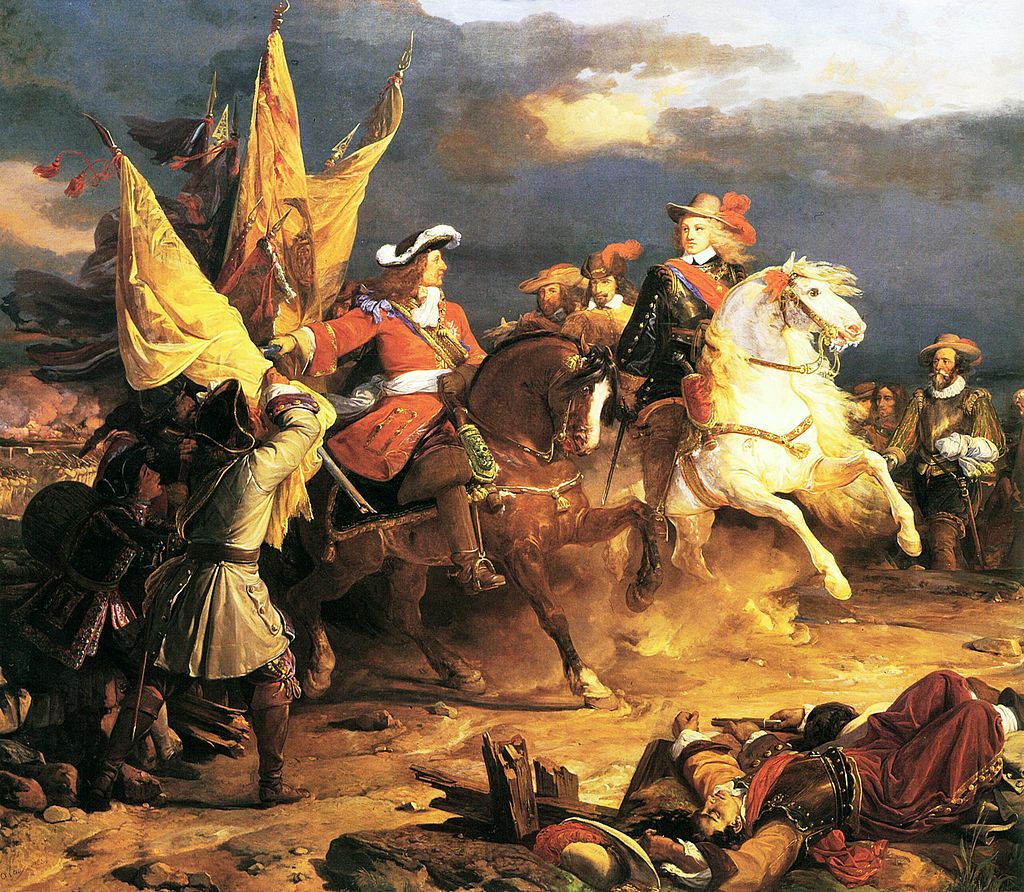
Philip V of Spain and the Duke of Vendôme pictured after the victory at the 1710 Battle of Villaviciosa

Philip V of Spain and the Duke of Vendôme pictured after the victory at the 1710 Battle of Villaviciosa
( Click image to enlarge)
Louis XIV had good reasons for accepting his grandson on the Spanish thrones, but he subsequently made a series of controversial moves: he sent troops to secure the Spanish Netherlands (the buffer zone between France and the Dutch Republic The Dutch Republic was a confederation that existed from 1579, during the Dutch Revolt, to 1795. It was a predecessor state of the Netherlands and the first fully independent Dutch nation state. Although the state was small and contained only around 1.5 million inhabitants, it controlled a worldwide network of seafaring trade routes. The income from this trade allowed the Dutch Republic to compete militarily against much larger countries. It amassed a huge fleet of 2,000 ships, initially larger than the fleets of England and France combined.); he sought to dominate the Spanish American trade at the expense of English and Dutch merchants; and he refused to remove Philip from the French line of succession, thereby reopening the possibility of France and Spain uniting under a single powerful monarch at a future date. To counter Louis XIV's growing dominance, England, the Dutch Republic, and Austria
The Dutch Republic was a confederation that existed from 1579, during the Dutch Revolt, to 1795. It was a predecessor state of the Netherlands and the first fully independent Dutch nation state. Although the state was small and contained only around 1.5 million inhabitants, it controlled a worldwide network of seafaring trade routes. The income from this trade allowed the Dutch Republic to compete militarily against much larger countries. It amassed a huge fleet of 2,000 ships, initially larger than the fleets of England and France combined.); he sought to dominate the Spanish American trade at the expense of English and Dutch merchants; and he refused to remove Philip from the French line of succession, thereby reopening the possibility of France and Spain uniting under a single powerful monarch at a future date. To counter Louis XIV's growing dominance, England, the Dutch Republic, and Austria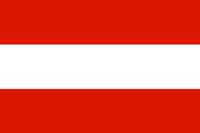 The Archduchy of Austria was a major principality of the Holy Roman Empire and the nucleus of the Habsburg monarchy. With its capital at Vienna, the archduchy was centered at the Empire's southeastern periphery. The archduchy's history as an imperial state ended with the dissolution of the Holy Roman Empire in 1806. It was replaced with the Lower and Upper Austria crown lands of the Austrian Empire. – together with their allies in the Holy Roman Empire
The Archduchy of Austria was a major principality of the Holy Roman Empire and the nucleus of the Habsburg monarchy. With its capital at Vienna, the archduchy was centered at the Empire's southeastern periphery. The archduchy's history as an imperial state ended with the dissolution of the Holy Roman Empire in 1806. It was replaced with the Lower and Upper Austria crown lands of the Austrian Empire. – together with their allies in the Holy Roman Empire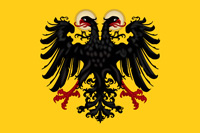 The Holy Roman Empire was a political entity in Western, Central, and Southern Europe that developed during the Early Middle Ages and continued until its dissolution in 1806 during the Napoleonic Wars. From the accession of Otto I in 962 until the twelfth century, the Empire was the most powerful monarchy in Europe. The empire reached the apex of territorial expansion and power in the mid-thirteenth century, but overextending led to partial collapse. – re-formed the 1680s Grand Alliance (1701) and supported Emperor Leopold I's claim to the whole Spanish inheritance for his second son, Archduke Charles. By backing the Habsburg candidate (known to his supporters as King Charles III of Spain) each member of the coalition sought to reduce the power of France, ensure their own territorial and dynastic security, and restore and improve the trade opportunities they had enjoyed under Charles II.
The Holy Roman Empire was a political entity in Western, Central, and Southern Europe that developed during the Early Middle Ages and continued until its dissolution in 1806 during the Napoleonic Wars. From the accession of Otto I in 962 until the twelfth century, the Empire was the most powerful monarchy in Europe. The empire reached the apex of territorial expansion and power in the mid-thirteenth century, but overextending led to partial collapse. – re-formed the 1680s Grand Alliance (1701) and supported Emperor Leopold I's claim to the whole Spanish inheritance for his second son, Archduke Charles. By backing the Habsburg candidate (known to his supporters as King Charles III of Spain) each member of the coalition sought to reduce the power of France, ensure their own territorial and dynastic security, and restore and improve the trade opportunities they had enjoyed under Charles II.
The English The Kingdom of England was a sovereign state on the island of Great Britain from about 927, when it emerged from various Anglo-Saxon kingdoms, until 1 May 1707, when it united with Scotland to form the Kingdom of Great Britain. The Viking invasions of the 9th century upset the balance of power between the English kingdoms, and native Anglo-Saxon life in general. The English lands were unified in the 10th century in a reconquest completed by King Æthelstan in 927., the Dutch and the Austrians formally declared war in May 1702. By 1708 the Duke of Marlborough and Prince Eugene of Savoy had secured victory in the Spanish Netherlands and in Italy, and had defeated Louis XIV's ally, Bavaria. France faced invasion and ruin, but Allied unity broke first. With the Grand Alliance defeated in Spain, and with its casualties mounting and aims diverging, the Tories came to power in Great Britain
The Kingdom of England was a sovereign state on the island of Great Britain from about 927, when it emerged from various Anglo-Saxon kingdoms, until 1 May 1707, when it united with Scotland to form the Kingdom of Great Britain. The Viking invasions of the 9th century upset the balance of power between the English kingdoms, and native Anglo-Saxon life in general. The English lands were unified in the 10th century in a reconquest completed by King Æthelstan in 927., the Dutch and the Austrians formally declared war in May 1702. By 1708 the Duke of Marlborough and Prince Eugene of Savoy had secured victory in the Spanish Netherlands and in Italy, and had defeated Louis XIV's ally, Bavaria. France faced invasion and ruin, but Allied unity broke first. With the Grand Alliance defeated in Spain, and with its casualties mounting and aims diverging, the Tories came to power in Great Britain The Kingdom of Great Britain was a sovereign country in Western Europe from 1 May 1707 to the end of 31 December 1800. The state was created by the 1706 Treaty of Union and ratified by the Acts of Union 1707, which united the kingdoms of England (which included Wales) and Scotland to form a single kingdom encompassing the whole island of Great Britain and its outlying islands, with the exception of the Isle of Man and the Channel Islands. in 1710 and resolved to end the war. French and British ministers prepared the groundwork for a peace conference and in 1712 Britain ceased combat operations. The Dutch, Austrians, and German states fought on to strengthen their own negotiating position, but defeated by Marshal Villars they had to accept Anglo-French mediation. The Treaty of Utrecht (1713) and the Treaty of Rastatt (1714) partitioned the Spanish empire between the major and minor powers. The Austrians received most of Spain's former European realms, but the Duke of Anjou retained peninsular Spain and Spanish America, where, after renouncing his claim to the French succession, he reigned as King Philip V until 1746. The European balance of power was assured.
The Kingdom of Great Britain was a sovereign country in Western Europe from 1 May 1707 to the end of 31 December 1800. The state was created by the 1706 Treaty of Union and ratified by the Acts of Union 1707, which united the kingdoms of England (which included Wales) and Scotland to form a single kingdom encompassing the whole island of Great Britain and its outlying islands, with the exception of the Isle of Man and the Channel Islands. in 1710 and resolved to end the war. French and British ministers prepared the groundwork for a peace conference and in 1712 Britain ceased combat operations. The Dutch, Austrians, and German states fought on to strengthen their own negotiating position, but defeated by Marshal Villars they had to accept Anglo-French mediation. The Treaty of Utrecht (1713) and the Treaty of Rastatt (1714) partitioned the Spanish empire between the major and minor powers. The Austrians received most of Spain's former European realms, but the Duke of Anjou retained peninsular Spain and Spanish America, where, after renouncing his claim to the French succession, he reigned as King Philip V until 1746. The European balance of power was assured.
HISTORY
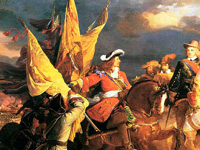
RESOURCES
This article uses material from the Wikipedia article "War of the Spanish Succession", which is released under the Creative Commons Attribution-Share-Alike License 3.0.
© Stories Preschool. All Rights Reserved.
